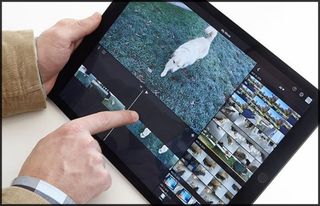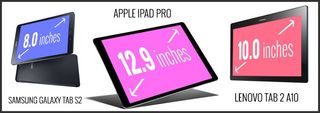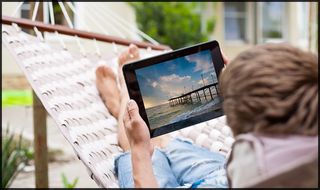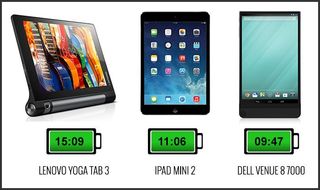Tablet Buying Guide: 8 Essential Tips
The tablet has fallen on hard times recently, with falling sales and heated debate about whether we even need tablets in today's huge smartphone-driven world.

But there are still plenty of good reasons to consider buying a tablet. Maybe you want a device to occupy your free time or to supplement your TV watching with Twitter. Maybe you don't need a full-fledged laptop, but need something that's bigger than a smartphone. Or maybe you're looking to buy an easy-to-use device for the technophobe in your life.
Whatever the reason, there's a tablet out there for you. Read on and we'll help you find the right one for your needs.
MORE: iPad Buying Guide: Which One is Right for You?
Convertible or Stand-Alone Tablet?
Why you can trust Laptop Mag
When it comes to tablets, you have a choice — do you go with a standard tablet or do you go with a “convertible” tablet?
Stand-alone tablets take the form of oversize smartphones: They consist of one large touch screen, a handful of buttons on the case, a charging connector and little else. They usually weigh between 1 and 2 pounds and are typically less than half an inch thick, so they're supercompact and portable. You control them using the touch screen, but you can usually pair them with a Bluetooth keyboard.
Convertible devices try to combine the flexibility of the PC with the convenience of a tablet. These 2-in-1 devices either come with a detachable keyboard or they're really just a full-size laptop that features a touch screen.
Detachables look and work like stand-alone tablets, but snap on to a specially designed keyboard attachment, and you can use them as laptop replacements. Some detachables come with the keyboard, while others require you to buy the keyboard separately, like with the iPad Pro and its $169 Smart Keyboard.
Microsoft's Surface Book takes the concept a step further, in that it's a full-fledged laptop with a detachable display that you can use as a stand-alone tablet.
Which Size?

Tablet screen sizes range from 6 inches on the low end, all the way up to a gargantuan 18.4 inches on Samsung's Galaxy View tablet. You'll find that most tablets fall into the 7- to 10-inch range: If you're looking for something small and light that you can take with you anywhere, a small tablet such as the iPad mini or 7-inch Amazon Fire tablet is the way to go.
Tablets in the 10-inch range, like the iPad Air 2, provide a good balance between portability and productivity: They aren't as easy to use with one hand, but they're still plenty light and compact. Larger tablets, such as the Galaxy View or the 12.9-inch iPad Pro, are less portable, but they can make for suitable laptop replacements.
Notebook-tablet hybrids typically feature screen sizes around 11 to 13 inches, but they tend to be bulkier, so they aren't ideal if size and weight are your main priorities.
Which Operating System?
iOS 9
The latest and greatest version of Apple's mobile operating system is iOS 9. It powers all of Apple's current-generation iPad models (as well as smartphones). And it comes with a number of additions that give your iPad a little extra flexibility, thanks to new split-screen multitasking features.
Your hardware options are limited with iOS, relative to Android and Windows, since you have only Apple's iPad line to choose from. The options include the iPad Pro, iPad Air 2, iPad Air, iPad mini 4 and iPad mini 2. On the other hand, iOS users have hundreds of thousands of apps at their disposal through the App Store.
Android
When it comes to Android tablets, you have no shortage of options — both in terms of hardware and software.
While Android is, ostensibly, Google's mobile operating system, there is no unified Android. The company releases a new update to the OS every year or so, and some tablets get updated while others do not. Plus, most tablet makers customize Android to suit their needs, or add in features to differentiate their tablets from the competition. Samsung tablets, for instance, come with a customized interface that integrates a number of Samsung-specific apps and features. Amazon's Fire tablets run a heavily customized version of Android that Amazon calls Fire OS.
You also have a plethora of hardware options, too — from the aforementioned Fire tablets to Samsung's wide-ranging offerings to the Asus ZenPad series, to name just a few.
Windows 10, the newest version of Windows, builds upon the foundation Microsoft laid in Windows 8 and 8.1. The new OS is easier to use on traditional PCs than Windows 8 was, and it makes using Windows on a tablet much more seamless than before. Windows 10 offers several concessions to tablet users, such as large, touch-friendly window controls and buttons, a Tablet Mode (which expands the Start menu to fill the whole screen) and various touch-screen gestures.
Windows remains heavily oriented around the keyboard and mouse, though, so some apps and features may be awkward to use via a touch screen. It makes sense, then, that many Windows tablets are of the convertible kind.
MORE: Top 8 Windows Tablet-Laptop Hybrids
How Will You Use It?

At Home
For general home use — such as Web browsing, email, listening to music and so on — most any tablet out there will fit the bill. You probably won't need to go with a superhigh-end tablet, so look for tablets that cost less than $300. The $179.99 Lenovo Tab 2 A10 is one of our favorites.
For Work
If you plan to use your tablet as a business machine — or as a laptop replacement — you'll want one with at least a 9-inch screen. The iPad Air and iPad Air 2, Google Nexus 9 and larger Samsung Galaxy models are all good choices.
If you have the budget, the 12.9-inch iPad Pro ($799 and up), Microsoft Surface Pro 4 ($899 and up) and Samsung Galaxy Note Pro 12.2 ($649 and up) are very good options. Each of these comes with handy multitasking features, optional keyboard attachments and pen-input support.
For Gaming
Since iOS is the center of the mobile gaming universe, an iPad is a good bet. The iPad Air 2 offers a good balance between portability and power, but starting at $499, it isn't cheap. Other options abound, however, such as the $199 gaming-centric Nvidia Shield tablet K1. This Android tablet is built around Nvidia's Tegra K1 quad-core mobile processor and features an 8-inch, 1920 x 1080-pixel display and 2GB of memory.
What about Windows-based convertible tablets? Since these devices run full-fledged Windows, you can play a good many PC games on them. They won't keep up with high-end gaming rigs, but many are more than suitable for more casual PC gaming.
For the Kids

With tablets for children, you'll want to consider size, price, durability and parental-control features. A 7-inch tablet will be more suitable for small hands, and given the risk of a broken tablet, you'll want to stay on the lower end — no more than about $250. The $99 Fire Kids Edition is a good choice, with its rubber bumpers, compact size, parental controls and kid-friendly interface. Plus, it comes with a two-year guarantee that says the company will replace it if your child does serious damage.
MORE: Kids' Tablets to Buy (or Avoid)
For Media Consumption
Any of the tablet ecosystems are good choices for watching movies or TV shows and listening to music, but if you're a true media junkie, the Amazon Fire HDX 8.9-inch may be for you. Not only does it feature a sharp 2560 x 1600-pixel display and Dolby Atmos speakers, but it also integrates nicely with Amazon's Prime Video content. Another great option could be the iPad Air 2, which integrates with iTunes and sports a 2048 x 1536-pixel screen.
What About Apps and Content?
All three major tablet operating systems provide digital storefronts from which you can purchase and download apps, music, movies and other kinds of content.
On iOS, the App Store is the only real way to get apps for your iPad. Apple keeps pretty tight controls over what apps you can buy through its store, which reduces the risk of downloading something malicious, but somewhat limits the sorts of things apps can do. The iTunes Store lets you purchase music, movies and TV shows, while the iBooks app manages all things pertaining to e-books. Meanwhile, the Music app lets you listen to your own tunes or stream music via the Apple Music subscription service.
Google Play is your official one-stop shop for getting apps, music and other content on your Android tablet. But Android's more open nature means it isn't the only way to get apps and other content, and Android device manufacturers sometimes bundle their own digital store on their devices.

Android devices can also side load Amazon's Underground app store. It comes with $20,000 worth of Android apps, games and in-app purchases that are free. It's a curated — and thus smaller — version of Google Play.
Speaking of Amazon, if you're an Amazon Prime member, the company's Fire tablets come with built-in support for Amazon Prime content. That includes the Video streaming service, access to Prime Music streaming, Kindle e-books and more. They also come with a 30-day Amazon Prime free trial. Apps are available for download via the Amazon Appstore or via the Underground app.
On Windows 10 devices, you can purchase apps, music and movies through the Windows Store. Because this is Windows, however, you can download apps from just about anywhere. Still, certain software titles may only be available via the Windows Store, and since Microsoft vets everything in it, you're at a lower risk of malware infection if you go through the Store.
Which specs matter?
Tablet specs can be tricky to discern, since not all manufacturers fully disclose their devices' innards. Here's a quick rundown on what you might see, and what it all means.
Processors
Apple uses its custom A-series chips inside its iPads. Current models use either the A7, A8, A8X or A9X processors: Higher numbers denote a newer processor that offers better performance, and the X suffix indicates a more powerful version of a given processor. The A8 is newer than the A7, for instance, while the A8X is a more powerful version of the A8.
Android tablets pack processors from a variety of manufacturers. Samsung's Exynos chips and Qualcomm's Snapdragon processors are the most common: Look for the Snapdragon 800 series and Exynos 8 processors for better performance. Nvidia's Tegra processors are found on Nvidia tablets, and you'll find some Android machines with Rockchip CPUs.
On the Windows front, you'll find mainly Intel processors, including the Core m3, i5 and i7 processors. Tablets based on Intel Core processors tend to be higher-end devices, and will generally cost you more. Lower-cost Windows tablets and convertibles often use Intel Atom processors.
MORE: Intel's Core M CPU: What You Need to Know
RAM (Memory)
RAM isn't quite as big a selling point on tablets because of how iOS and Android manage memory. Generally speaking, however, the more you spend, the more RAM you'll get, and on most tablets, you can expect anywhere between 1GB and 4GB of memory. Laptop/tablet hybrids and other Windows-based convertible tablets, like the Surface Pro 4, typically offer more memory, sometimes up to 16GB of RAM. More RAM often equates to snappier performance.
Storage and Expandability
Stand-alone tablets typically come with 8 or 16GB of storage on the low end, and up to 128GB on the high end. Convertible Windows tablets often have storage capacities more in line with typical notebooks, so it isn't unusual to find one with 256GB of storage or more. Some tablets include SD card readers that allow you to expand your device's storage capacity. Unless you don't use your tablet much, you may find 8 or 16 GB to be a little too constraining for your needs, so you'll probably want to pay a little more and get at least 32GB of storage space — or look for one with an onboard SD card slot.
How About Battery Life?

Many tablets will get you all-day battery life, but as our testing shows, tablet battery life can still vary greatly. Lenovo's Android-based Yoga Tab 3 lasted more than 15 hours on a single charge in our Web browsing tests, but on average, the devices we tested ran for 8 hours and 45 minutes before their batteries ran dry. We recommend you look for a tablet that runs for no less than 7 hours on a single charge.
MORE: 10 Tablets with the Longest Battery Life
Is the Price Right?
You can pay an awful lot for a tablet — but you don't have to. Tablets range from more than $1,000 on the high end to less than $50 on the low end, so you have plenty of options, regardless of how much or how little you want to spend.
Less than $100
You'll find lots of inexpensive Android tablets for less than $100, as well as Amazon's entry-level 7-inch Fire tablet, a solid little device that goes for around $50. At these prices, though, you're limited to tablets with tight storage capacities and low-resolution displays, and you won't find many that have screens larger than 7 inches. You'll want to do your homework before you buy to make sure you're getting a decent device.
$100 to $200
If you're on a tight budget but don't want to delve into the bargain basement, the sub-$200 range is a good place to look. Most tablets in this price range hover around 7 or 8 inches and run Android, such as the 7-inch Samsung Galaxy Tab 4. Storage capacities are still limited, though, with 8 or 16 GB being the norm, but you'll find the occasional tablet with 32GB of onboard storage.
MORE: Best Tablets Under $200
$200 to $300
Pay a little more, and you'll get a little more power and added niceties, such as higher-resolution screens. At $269, Apple's low-end iPad mini 2 gets you a 7.9-inch 2048 x 1536-pixel display, but its storage capacity is limited to 16GB. At this range, you'll start to see larger 9- and 10-inch tablets as well.
$300 to $400
Here is where you'll start to see more of the larger, higher-end tablets. High-end 7- and 8-inch tablets live here, as do lower-end 9- and 10-inch tablets. For $319 you get a 32GB iPad mini 2, while $399 gets you either a 16GB iPad Air or 16GB iPad mini 4. Alternatively, you'll find the $399 Google Nexus 9 tablet and a wide selection of Galaxy tablets from Samsung.
$400 and up
The high end of the tablet market is a rather wide-ranging segment, but it's here where tablets go from being secondary devices to legitimate laptop replacements. You'll get faster processors, bigger screens, more features and, generally speaking, more storage space (though you'll still find some 16GB models here and there). You'll also find tablets with built-in cellular broadband here. Tablets in this range include the iPad Air 2, the iPad Pro, high-end Android tablets and the Surface Pro 4.
- Laptop Buying Guide: 9 Essential Tips
- Smartphone Buyers' Guide: 7 Things You Need to Know
- Top 10 Tablets to Buy (or Avoid) Now
Tablet Guide
- Kids Tablets to Buy (or Avoid)
- 10 Tablets with the Longest Battery Life
- The Best Tablets for Less Than $200
- Chromebook vs. Tablet: Which Should You Buy?
- Why 4G Tablets Are a Total Rip-Off
- How to Sell, Trade In or Donate Your Old Tablet
- iPad Buying Guide: Which One is Right for You?
- How to Use Your iPad as Your Only PC
Stay in the know with Laptop Mag
Get our in-depth reviews, helpful tips, great deals, and the biggest news stories delivered to your inbox.
